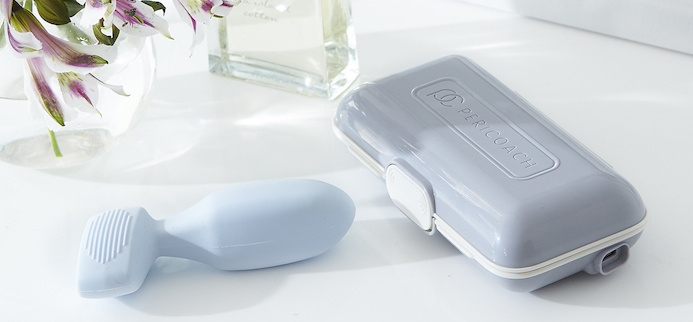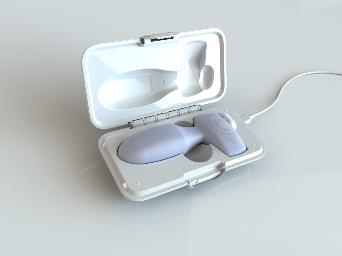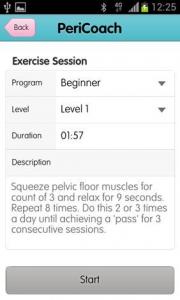One in three women suffer with Urinary Incontinence (UI) yet only half ever seek help. Now, a new gadget launched today is set to change that. The Pericoach works like a personal trainer for your pelvic floor, delivering proven treatment with an app that tracks your day-to-day progress
If you spoke to more than three women today, the chances are that one is quietly suffering with urinary incontinence (UI). Strikingly common, yet among the least talked about health issues of our day, as many as six million people in the UK – most of them women – suffer with UI according to the Bladder and Bowel Foundation. Yet 50 per cent will never report it. A new medical device launched this week promises to treat the issue with measurable data and deliver a cure.
The Pericoach is the UK’s first ‘smart-tech’ total pelvic floor muscle training system designed to help treat urinary incontinence. It’s a discreet, at-home device and smartphone app that helps women train their pelvic floor muscles through app guided exercises, and removes the guesswork by monitoring progress as the muscles gain strength and reduce the risk of embarrassing leaks.
What are the symptoms of UI?
The most common symptoms of UI include leaking urine when you laugh, jump, dance, sneeze or cough. It may also happen during sexual intercourse too.

What causes it?
One in three women in the UK will experience bladder leaks at some point in their lives, a common but not normal condition.
most common causes include pregnancy and childbirth, being overweight or having diabetes, the menopause, regular running, jumping or strenuous exercise
‘As a GP I regularly recommend Kegel exercises to help strengthen the pelvic floor,’ says Dr Pixie McKenna, GP and presenter of Channel 4’s Embarrassing Bodies. ‘Bladder leakage can be a consequence of pregnancy, childbirth, menopause, high impact sport or physical activity. As a result the muscles that support the pelvic floor become weakened or damaged leading to embarrassing leakage. Other causes include severe constipation, weight gain and on occasion hormonal changes in young women in the pre-menstrual week.’
UI can be exacerbated by lifestyle issues such as drinking too much coffee which is a diuretic which can aggravate an overactive bladder. While up to half of women will suffer in silence, the good news is UI is usually a problem that can be treated.
What’s the current treatment?
Current first-line treatment guidelines from the National Institute of Clinical Excellence (NICE) for UI suggest a series of pelvic floor muscle training supervised by a physiotherapist for three months. This involves doing your Kegel’s exercises. That is, contracting your pelvic floor eight times and practicing this at least three times a day. Kegel exercises were invented by American gynaecologist Dr Arnold Kegel, who first published his ideas in 1948. They can be done anytime, anywhere by contracting the muscles around your vagina and anus, which should feel like you’re trying to hold back urine or gas. You hold the contraction for a count of ten then repeat eight times and practice this three times a day.
Studies have shown a 70 per cent improvement in symptoms of stress incontinence across all age groups following a course of pelvic floor exercises. In fact, it can also help improve sexual function. However according to physiotherapists, while pelvic floor strengthening is the leading treatment recommended by pelvic, obstetric and gynaecological physiotherapy for UI, doing them can be daunting and frustrating, particularly when results are hard to monitor. In fact, up to 50 percent of women are unsuccessful when they are given verbal or written direction alone.
Pericoach – the new gadget that can help
Pericoach is a medical device that monitors not only the user’s performance of their pelvic floor strengthening exercises, it also tracks their results providing real time feedback on their progress and a constant stream of how-to instructions.
How does the Pericoach work?
The device is inserted into the vaginal canal where three biofeedback sensors built into it do most of the work. These are force sensors that detect the force of the muscles of the pelvic floor as you contract and relax them. Once you contract your pelvic floor muscles, the sensors in the Pericoach detect the contractions and send a report to your smartphone via Bluetooth, providing a constant flow of information to show the user their progress information. Good news is, this info is also available to your GP, physiotherapist or other healthcare provider.
Pericoach’s ‘smart tech’ programmes
The PeriCoach comes with a downloadable app, which is free from the Apple Store or Google Play and provides real time audio and visual feedback during your exercises. It also sends you regular reminders to motivate you to do them. There’s also a secure website my.pericoach.com that shows you and your clinician your progress.
The PeriCoach provides a detailed programme of exercises that progressively increase in difficulty as your pelvic floor gets stronger. Just connect the device to your app and start with the Beginner’s programme. The exercises vary in duration but generally last 2-3 minutes each and you must successfully complete each level of exercises before you are allowed to move on to the next level. There are beginners, intermediate, advanced and maintenance programmes. During each exercise in each programme, the app tells you when to squeeze, how long to hold for and when to relax, plus how often to perform your moves. Doing the moves therefore is easy as it literally talks you through every step of working your pelvic floor and then provides daily feedback on how you’re doing.
So, does it work?
Approved as a medical device by the stringent Federal Drug Administration (FDA) in the US, clinical trials of the device are in progress. However, in patient reports from physiotherapists using the device in their clinic, one notes that a case study, ‘in three months went from soaking through an adult diaper while running to being able to run three miles with no leaking and no pads.’ Another case study Cate, says: ‘Since using the PeriCoach I’m back in the gym without the worry of wetting my pants!’
It’s like having you own personal physiotherapist in your handbag
‘The key factor in restoring the pelvic floor muscles is not just about doing the Kegel’s exercises, it’s about doing them consistently and correctly and identifying the right muscles,’ says Dr McKenna. ‘For example, many women push down rather than pull up which can sometimes exacerbate a pelvic problem. PeriCoach addresses both of these issues by showing a woman in real-time her performance during a series of pelvic floor exercises and the ability to track progress over time.
‘PeriCoach’s smartphone technology also has reminders that are sent to encourage women to continue exercising and improve their scores,’ explains Dr McKenna. ‘It’s like having you own personal physiotherapist in your handbag and also means you don’t forget!”
It leaves one question: why didn’t they think of this before?
The Pericoach costs £145 from pericoach.com. It comes in a mobile storage case with a recharging cord. World Continence Weeks runs from the 22nd to the 28th of June
Like this article? Sign up to our newsletter to get more articles like this delivered straight to your inbox.
















































































































